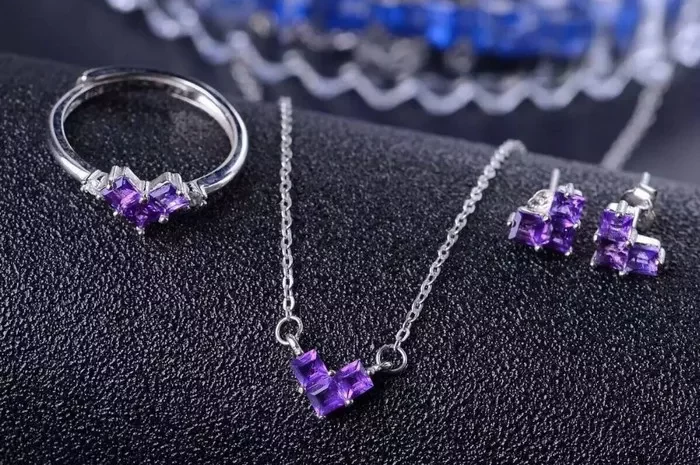Amethyst, with its captivating beauty and rich history, has long held a place of honor among gemstone connoisseurs and collectors. Renowned for its regal purple hues and mystical allure, amethyst commands a significant price tag in the world of gemstone commerce. In this in-depth exploration, we delve into the multifaceted reasons behind the expensiveness of amethyst, shedding light on the intricate factors that contribute to its esteemed value.
Amethyst: A Brief Overview
Before delving into the reasons behind its expense, it’s essential to understand the allure of amethyst and its esteemed place in the world of gemstones. Amethyst derives its name from the Greek word “amethystos,” meaning “not intoxicated,” reflecting ancient beliefs that the gemstone could ward off drunkenness and promote sobriety. Throughout history, amethyst has been associated with nobility, spirituality, and enlightenment, earning it a place of reverence in cultures around the world.
Prized for its rich purple hues, amethyst is a variety of quartz that owes its distinctive color to trace amounts of iron and other impurities within its crystal structure. From the pale lilacs of Rose de France to the deep violets of Siberian amethyst, the spectrum of colors exhibited by amethyst is as diverse as it is enchanting. It is this captivating beauty, combined with its scarcity and symbolic significance, that contributes to amethyst’s reputation as a highly sought-after gemstone.
Why is Amethyst So Expensive
Despite its widespread availability, amethyst is often associated with a hefty price tag, especially for high-quality specimens. Several factors contribute to the expensiveness of amethyst, each playing a crucial role in determining its market value. Let’s unravel the enigma and explore the key reasons behind amethyst’s esteemed price:
1. Rarity and Geographic Origin:
While amethyst is relatively abundant compared to other gemstones, high-quality specimens with exceptional color and clarity are rare and highly prized. The most coveted varieties of amethyst often hail from specific geographic regions renowned for their superior quality. For example, Siberian amethyst, characterized by its deep violet hues and exceptional transparency, commands a premium due to its scarcity and geological origin in Russia’s Ural Mountains.
Similarly, Uruguayan amethyst is celebrated for its rich purple tones and impressive crystal formations, making it highly sought after by collectors and enthusiasts. These regional distinctions, coupled with limited availability and mining restrictions, contribute to the rarity and exclusivity of certain varieties of amethyst, driving up their market value.
2. Color and Clarity Grading:
Color and clarity are paramount factors in determining the value of an amethyst gemstone. The most desirable hues are rich, saturated purples with minimal zoning or color banding, as these characteristics enhance the gemstone’s beauty and visual appeal. Amethysts with deep, uniform coloration are often considered more valuable than those with lighter or uneven tones.
In addition to color, clarity also plays a crucial role in assessing an amethyst’s value. High-quality specimens exhibit minimal inclusions and imperfections, allowing light to pass through the gemstone unimpeded, resulting in optimal brilliance and sparkle. Gemologists use standardized grading systems, such as the GIA’s clarity scale, to evaluate the quality of amethyst specimens and assign them appropriate value based on their color and clarity characteristics.
3. Cut, Carat Weight, and Craftsmanship:
The cut, carat weight, and craftsmanship of an amethyst gemstone significantly influence its market value. Well-executed cuts, such as the brilliant, step, or mixed cuts, maximize the gemstone’s brilliance and fire, enhancing its overall beauty and desirability. Larger, well-proportioned amethysts with optimal carat weights are often more valuable than smaller or irregularly shaped specimens due to their rarity and visual impact.
In addition to the gemstone itself, the quality of the setting and craftsmanship of the jewelry piece also contribute to its overall value. Intricate designs, meticulous detailing, and the use of high-quality materials, such as platinum or gold, can significantly enhance the perceived value of an amethyst jewelry piece, making it more desirable to discerning buyers and collectors.
4. Market Demand and Trends:
Market demand and consumer trends play a significant role in determining the price of amethyst gemstones. Fluctuations in demand, driven by factors such as changing fashion trends, cultural influences, and economic conditions, can impact the perceived value of amethysts in the marketplace. For example, increased demand for sustainable and ethically sourced gemstones has led to a growing interest in responsibly mined amethysts, which may command a premium due to their eco-friendly and socially responsible credentials.
Similarly, cultural factors and symbolic associations can influence the desirability and market value of amethyst gemstones in different regions and demographics. For example, amethyst’s association with spirituality, healing, and inner peace may resonate with consumers seeking gemstones with metaphysical properties, driving up demand and prices for high-quality specimens.
In Conclusion
As we’ve explored in this comprehensive examination, the expensiveness of amethyst is influenced by a myriad of factors, ranging from its rarity and geographic origin to its color, clarity, and market demand. While amethyst may not command the astronomical prices of rare diamonds or colored gemstones, its timeless beauty, rich symbolism, and enduring allure ensure its esteemed place in the world of gemstone commerce. Whether adorning a piece of fine jewelry or serving as a cherished keepsake, amethyst continues to captivate hearts and minds with its mystical charm and enigmatic beauty.


